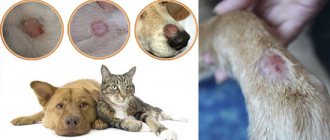In what cases should you immediately contact a veterinarian?
It must be remembered that the appearance of blood from the mouth of an animal can be explained by harmless and relatively harmless reasons, when there is no need to panic too much.
But in other cases, it is necessary to immediately take the pet to the clinic, or immediately call a specialist to your home:
- Blood flows from the mouth in copious streams.
- Discharge of large blood clots from the mouth.
- The animal noticeably weakens, all visible mucous membranes turn pale, become cool and sticky.
- In any case, you need to look at the color of the blood. If it is bright red and comes out in large portions, there is a high probability of internal arterial bleeding. Darker clots are a sign of venous hemorrhage, which is not so dangerous to the health and life of the dog.
Diagnosis and treatment of hematemesis in dogs
All pet owners should know that vomiting blood is a sign of serious health problems. In this case, it is necessary to immediately contact a specialist to establish a diagnosis and begin treatment.
The most effective diagnostic methods:
- Complete analysis of blood, urine and feces;
- Blood chemistry;
- Ultrasound and x-ray of internal organs, abdominal cavity and chest;
- Advanced blood test for coagulation;
- Gastrointestinal tract studies;
- Endoscopic examination of the digestive system.
Most common causes of mouth bleeding
In veterinary practice, the most common causes of bleeding from a dog's mouth are:
- Gum injuries. This often happens to dogs whose owners “feed” their pets bones. The fragments of the latter wound and injure the delicate gum tissue, resulting in bleeding. Of course, it is not too dangerous in itself, but injured gums are the gateway to infection. If inflammation develops, the dog can easily lose a tooth, or even die from sepsis.
- Other injuries of soft tissues of the oral cavity. There are a lot of blood vessels passing through the soft tissues of the mouth, and therefore any damage to them is fraught with heavy bleeding. This phenomenon is fraught with the same thing as in the previous case (i.e., infections and inflammations).
- Damage and loss of teeth. This often happens with injuries. Dogs' teeth are quite thin, they are covered with a rather weak layer of enamel. Accordingly, under sufficiently strong mechanical stress, they are easily damaged and even break off at the very root. This often leads to quite heavy bleeding.
- The oral cavity is directly and indirectly connected to the nasal cavity, blood can drain from there . True, in such cases, some amount of blood will still be released from the nasal passages.
Symptoms and forms of parvovirus
Parvovirus enteritis is divided into two forms:
- Intestinal. It is transmitted through oral contact with feces or surfaces containing traces of an infected dog.
Spread of parvovirus:
- Release of infected dog excrement into the environment;
- Entry into the body of a healthy animal through the nose or oral cavity;
- The virus begins to multiply on the lymphoid tissue in the throat and is transmitted to the bloodstream, where it begins to destroy blood cells;
- Having penetrated the bone marrow and lymph nodes, parvovirus leads to the destruction of the hematopoietic system;
- When the intestinal mucosa is damaged in the small section, the first symptoms of intestinal enteritis appear. At the specified time, observation by a veterinarian and the prescription of rational treatment are required. The destruction of mucous membranes is accompanied by dehydration of the body and a violation of blood composition;
- Added to the effect of the virus is the introduction into the bloodstream of various microflora that penetrate through damaged intestinal walls;
- Sepsis, which occurs due to a complex of negative influences, leads to death without proper treatment.
- Heart. Parvovirus infection develops not only in the intestines, but also affects the heart muscle. It is observed in puppies infected in the mother's womb, less often - at birth, with the adoption of infected milk.
Pathogenesis of cardiac form of enteritis:
- The virus is localized in the tissues of the heart of the developing fetus;
- From birth, parvovirus destroys immune cells and intestinal mucous membranes, causing secondary infections to occur simultaneously in two locations;
- Myocarditis develops - inflammation of the heart muscle;
- A lethal outcome occurs if small areas of necrosis develop on the puppy’s heart muscle and due to general sepsis against the background of secondary infections.
The incubation period of the disease is 5-7 days, in some cases it is reduced to two or increased to fourteen. Primary signs of infection include lethargy, decreased appetite, fever, vomiting or diarrhea that persists for a maximum of two days.
In severe cases of the disease, symptoms are usually similar to:
- Shallow short-term fainting;
- Lightening of mucous membranes;
- Weak, rare pulse;
- Decreased body temperature.
In the intestinal form of the disease the following are recorded:
- Lethargy, apathetic state of the animal;
- Refusal to eat;
- Vomiting, sometimes with blood;
- Body temperature exceeds normal by a maximum of three degrees;
- Watery diarrhea with mucous patches, progressing to foul-smelling diarrhea with blood;
- Severe weakening of the dog's body.
The most dangerous types of mouth bleeding
As we wrote above, some cases of bleeding from the mouth are extremely dangerous not only for the health, but also for the life of the dog. Here are their types and distinctive features:
- Pulmonary hemorrhages. This happens with severe injuries, infectious diseases, etc. This type of bleeding is characterized by the release of scarlet and foamy blood from the mouth, and the dog also coughs violently and painfully. Often there are noticeable problems with breathing, it is tense and difficult, all visible mucous membranes turn blue and pale. If the animal is not provided with timely assistance, it will most likely die.
- Gastrointestinal bleeding. In these cases, dark red or simply dark blood is released from the dog's mouth, which in such situations may more closely resemble meat slop. In addition, during defecation, dark or even black stool is released (the so-called melena). As in the previous case, it is important to help the dog in time, otherwise it will die.
- Poisoning with rat poisons. As a rule, these drugs are based on zoocoumarin, which blocks blood clotting, and therefore, in case of poisoning with them, intense and varied bleeding is possible. The blood is liquid and does not clot at all.
How to give first aid to a bleeding dog
The set of measures that need to be taken to provide first aid to an animal at a critical moment is selected depending on the type of bleeding. If the signs suggest internal hemorrhage, the owner without experience will not be able to stop the process. You need to seek help from a doctor.
The veterinarian selects a set of measures only after identifying the diagnosis and determining the type of bleeding. Since symptoms of internal pathology are not detected immediately, but only after several hours or even days, measures must be taken immediately once the problem is identified.
In case of nasal hemorrhage, it is necessary to limit the dog’s body movements, especially his head. Because this only increases blood pressure and flow. You need to make a cold compress, for example, from ice, and apply it to the bridge of your nose or head. This will relieve pain and help stop blood flow. However, this method will only be effective if there has been damage to the nasal mucosa. If the cause is deeper, for example, internal pathologies, then qualified help from a doctor is needed.
If the bleeding is external, then depending on the type of damaged vessel and symptoms of damage, appropriate measures must be taken.
- Venous bleeding is stopped using a bandage. If this does not help, then it is necessary to tighten the tourniquet below the wound and loosen it after a while so that tissue atrophy does not occur due to insufficient blood flow. The best thing to do is to apply a tight bandage to the wound and take your pet to the hospital within 2-3 hours.
- Arterial hemorrhage can only be stopped with the help of a tight tourniquet, which is applied above the wound and not on it.
- Capillary bleeding stops under the influence of cold. This provokes a narrowing of the resulting lumen and cessation of blood flow.
It is impossible to stop uterine bleeding on your own, and it makes no sense. Because it requires specialist intervention along with proper treatment.
First aid at home
In all of the above cases, we strongly recommend that you immediately consult a veterinarian! But in situations where this is not possible for some reason, the following steps must be taken:
- You need to provide your pet with complete rest. There is no need to play with him, panic, or run around the dog. The more nervous the animal is (and it perfectly senses the mood of its owner), the more it bleeds!
- In case of pulmonary bleeding, it is advisable to wrap the dog in a sheet soaked in cold water.
- It is not advisable to give a lot of drink, especially if you suspect poisoning with rat poison. Veterinarians recommend giving water with pieces of ice and very small portions.
- If the veterinarian cannot come to the house, the animal must be taken to him urgently. Ideally, you need to carefully place the pet in a spacious basket or, if the animal is large, use a stretcher to carry it. The dog must not be allowed to walk on its own, as walking will worsen its condition!
Treatment
No specific treatment for parvovirus has been found. Vaccination is considered the only way to protect small puppies from developing the virus. The method is not always effective.
Treatment started in the early stages of enteritis is more likely to lead to recovery. The age of the sick animal also has a significant impact on the effectiveness of treatment. Most often, very young or, conversely, old individuals cannot withstand radical treatment methods.
Treatment methods:
- Intravenous administration of classical colloid solutions and antibiotics;
- Injections of antiemetic substances;
- Additional compounds to support the vital functions of the animal’s body - saline solutions, immunostimulants, glucose, vitamins.
What else should you pay attention to?
It is imperative to take into account the nature of vomiting. Blood in vomit can have different appearances. It happens:
- fresh, bright red;
- overcooked (resembles coffee grounds);
- may look like clots.
Did you know? Food moves in the esophagus due to peristalsis. This property allows her to continue moving even when her body position has changed to any other.
The nature of the gag reflex
Vomiting is a normal reaction of the body. In this way, it is cleared of “excess” and those substances that cannot be processed. Therefore, one-time vomiting is a condition that should not bother the dog owner.
Older animals vomit more often. Their bodies produce more mucus. Dogs regurgitate it, sometimes choke, which causes vomiting. This condition also does not require human intervention.
In case of infectious diseases or helminthic infestation, vomiting will be repeated frequently. If you observe these and other symptoms of ill health, your dog should be taken to a veterinarian for diagnosis and treatment.
Smell and color of vomit
Vomit may have a specific color and smell.
Analyze the symptoms in more detail:
- The least worrisome explanation for vomiting blood would be a cut in the mouth. This happens when chewing on an object such as a bone or when playing with another dog.
- A more dangerous situation will be when the dog has injured the esophagus with bones and it is necessary not only to stop the bleeding, but also to remove the bone fragment.
- Blood that is fresh, bright red, and has a high mucus content is a problem that is associated with the upper gastrointestinal tract (mouth, esophagus, and stomach). Perhaps there is an inflammatory process occurring there or there is a wound, an ulcer that is bleeding.
- Blood with bile is the morning “bilious vomiting syndrome.”
- With white foam - the result of the movement of undigested food through the esophagus to the stomach and back. The most likely cause is intestinal obstruction or infectious inflammation.
- Dark red clots are digested blood. This means that the bleeding has already been going on for some time and that part of the blood that entered the stomach has had time to be partially digested. This type of vomit will also smell bad.
Did you know? Many people believe that the stomach is the main organ of the digestive system. But that's not true. The main processes of food breakdown occur in the dog's small intestine.
Causes of development of peptic ulcer
An ulcer is an eroded area of the gastric mucosa that occurs due to the interaction of tissue with pepsin and hydrochloric acid. Therefore, the pathology is often called peptic. In acute lesions, the mucous membrane is covered with multiple erosions; in chronic lesions, they are focal in nature, penetrating deep into the tissues, and the edges of the ulcers rise.
Peptic ulcer disease often occurs against the background of an inflammatory process that occurs in the stomach. Without timely, competent treatment, due to non-compliance with the therapeutic regimen, the course of gastritis can become significantly more complicated.
Probable causes of hematemesis
A possible cause can be suggested by the appearance of the vomiting and accompanying symptoms. The most common ones include
:
- Gastrointestinal infections
(enteritis, leptospirosis, hepatitis). When infected with viruses or other pathogenic microorganisms, fever and severe weakness are observed. Parvovirus enteritis, accompanied by acute diarrhea, is especially dangerous for puppies. If severe dehydration occurs, a small pet may die.
- Ulcerative
formations
. Thinning of the walls of the gastrointestinal tract, caused by poor diet or frequent infections, is fraught with the formation of bleeding ulcers. The disease is accompanied by alternating diarrhea and constipation. Bloody clots appear in the stool and vomit. - Oncological
diseases
. Bloody vomiting with cancerous tumors appears in the later stages. It is important to seek help as quickly as possible to prevent the development of metastases.
Internal organ
injuries caused by a foreign object entering the throat, stomach or intestines. Damage to the larynx is accompanied by wheezing and coughing, and injuries to the stomach are accompanied by acute pain.- Poisoning
by poisons
. Intoxication is accompanied by vivid and rapidly developing symptoms. The animal requires urgent hospitalization. - Acute
helminthiases
. If the dog has vomited adult parasites, larvae or eggs, then the cause of hematemesis is obvious. Worms can also be passed out in the feces. When intoxicated by helminth waste products, stool disturbances, abdominal pain, weakness and dulling of the coat are noted. In particularly severe cases, intestinal obstruction occurs. - Kidney
failure
. This condition is accompanied by an ammonia smell from the mouth.
The risk group includes animals with chronic diseases and pets taking non-steroidal anti-inflammatory drugs (Ibuprofen, Diclofenac). These medications reduce the number of platelets, which are responsible for the elasticity of blood vessels. As a result of thinning of the vascular walls, bleeding occurs.











